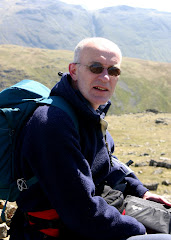At the start of day 9 the route could easily head south west and coincide with the route taken by Wainwright but that would once again mean following a busy road so the new route covers the ground covered at the end of day 8 in returning to "Close Houses" (now the Christian Centre) and on to the village of Knock. The old map shows an inn at Knock but I don't recall seeing one - details of the inn would be interesting.
The route then crosses the meadowland and finally rejoins Wainwright at Marton House just north of Long Marton where the old and new follow one another for a short distance before diverging again. Long Marton boasts railway line that is still operating - it is the famous Settle - Carlisle line that was last seen on day 1.

Wainwright followed the road to Brampton and south to Appleby in an ever-deepening mood of boredem made worse by seeing the Lakeland fells away to the west. The new route takes the opportunity of using a Roman Road near "Far Broom" which it follows for a mile and once again joins the old route for the final walk into Appleby.
Wainwright did not enjoy Appleby on his visit in 1938 as it was raining and he was questioning why he had not planned his walk to end at Hadrian's Wall and he stated that Appleby was "...soon entered and soon left behind." I thought Appleby was a delight and would like to know which cafe Wainwight called at (how many cafes were there in 1938 that had a "big room" and dirty tablecloths?).

From Appleby the routes diverge again because Wainwright followed the road (again) heading generally south for what he described as a three hour walk to Kirkby Stephen which was his goal. The new route follows the west bank of the river Eden and around the tight bend, under the railway which passes overhead on a large viaduct and on into Great Ormside.

Leaving Great Ormside the way quickly passes through Little Ormside before once again generally following the course of the river. All down this stretch there are a number of fords noted on the river on the old maps - details about these fords would be interesting because when I visisted for research (in 1999) there was no possibility of fording the river which had been Wainwright's experience north of Alston.
During his ninth day Wainwright had walked in horrendous weather and he remarks in his narrative that he saw a newspaper headline the next day that read how a great gale swept Britain - was this artist's license or was there such an article in early October 1938?
The route passing Sandford and Warcop is amongst a maze of paths and bridleways but the only alternative is the road taken by Wainwright. so the paths it must be.

The confusion of paths is over on the final part of the day's walk which heads south from "Ploughlands" following meadows and just before reaching Soulby it rejoins the Wainwright route.
Wainwright stayed at the Black Bull Inn at Soulby. Who was the "raven-haired"landlady in 1938? He spent an interesting evening with the loud local who was known as "Rowley". Who was Rowley and what were the circumstances around the Black Bull being demolished - all that remains now is a patch of grass. In fact, in years gone by there was a second hotel in this small village and details of both would be very interesting.
He also referred to an older lady, Alice who he considered to be about 50. It would be interesting to know her history as well.

APPENDIX:
The following maps show the start section of Wainwright's ninth day when he had set off from Gamblesby. He passed through Melmerby and headed via road south toward Appleby that had been his goal the day before.

The Wainwright route continued through Skirwith and Blencarn on roads that he found increasingly frustrating with high hedges that obscured any views to either side.

He passed through Milburn and, after about 11 miles, he arrived at last where he would have been had he proceeded via Cross Fell the day earlier.

There are no more such major divergences between the two routes and the final 2 days walking see the routes as close together as pleasant walking permits.
Day 9 is not one of the highpoints of the walk except for Appleby which is pleasant for a pause, hopefully in a cafe with clean tablecloths and also for Soulby which is small enough to be able to find some connection with the past.
Under construction

1 comment:
The landlady of the Black Bull at Soulby on 29 September 1939 was Margaret Morley, born 21 April 1897 and married, although there was no husband listed at the Black Bull on that date. See 1939 Register, RG101/3115I or L/005/16 Code Letters HGBD
Post a Comment